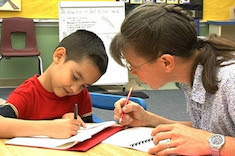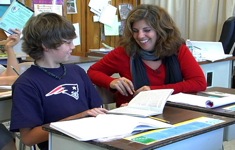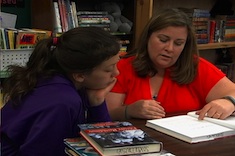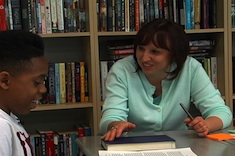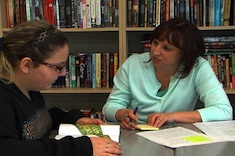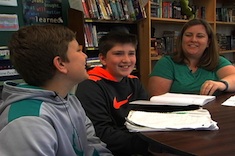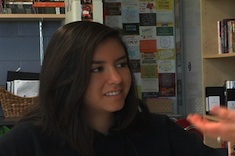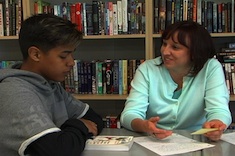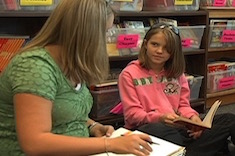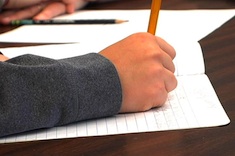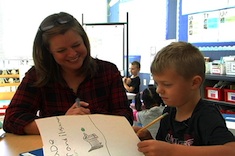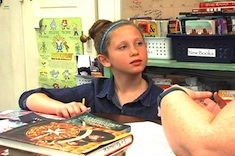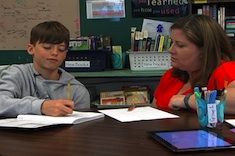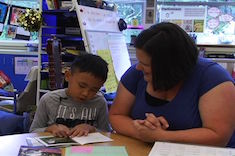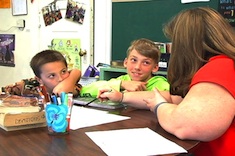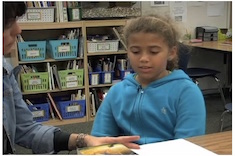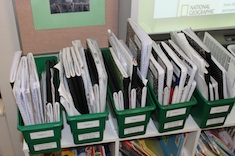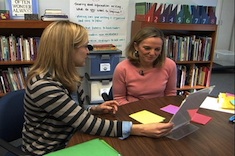Conferring
The teachable moment is what we live for - is there anything more magic than reaching a reader or writer with exactly the right words at exactly the right time? We've bottled some of that magic in the resources that follow, with print guidelines and scores of video examples from master teachers.
Latest Content
Conferring Notes
When it comes to conferring notes, form needs to follow function. Dana Murphy quit looking for the perfect template, and started focusing on what kinds of notes are most helpful.
Conferring: Establishing a Setting in a Novel
In this week's video, Aimee Buckner has a quick conference with a fourth grader about ways to solve a dilemma — how to figure out the setting in a historical fiction novel when there are no pictures.
Building a Next-Read Nonfiction Stack
Katherine Sokolowski helps fifth grader Jack build a next-read stack of nonfiction, highlighting a variety of text features and historical references.
Peer Support in Writing Workshop: Conferring with Jaden
Christy Rush-Levine meets with eighth grader Jaden, who talks through his struggles in writing a conclusion to his literary analysis, and how his peers helped him improve the writing.
Close Attention and Reading Response: Conferring with Tori
Christy Rush-Levine confers with eighth grader Tori about her reading response to Why We Broke Up. She encourages Tori to make connections between the characters in her current book and her previous reading by paying close attention to surprising action.
First-Grade Conference: Stretching Writing
Katrina Edwards helps her adorable first-grade student Dylan stretch out his writing. He adds details by first talking about playing with friends near his home.
Teaching Fifth Graders to Make Peer Recommendations
Katherine Sokolowski confers with her son Liam and his friend Caden, helping them learn how to make peer book recommendations.
“If You Like” Reading Recommendations Conference
Building "next-read" stacks with students before holidays is a great way to ensure they have books in hand that they will be excited to read over break. Katherine Sokolowski helps Taryn finds books that are similar to those written by Rick Riordan (Taryn's favorite author).
Writing a Strong Conclusion to a Literary Analysis Essay
Christy Rush-Levine helps eighth grader Katherine sort through tools and strategies for writing a strong conclusion to her literary analysis essay.
Eighth-Grade Conference: Empathetic Reading
Christy Rush-Levine confers with eighth grader Julian about his strengths as an empathetic reader.
Super Teacher Reading Workshop
Mary Lee Hahn tries to be super teacher while she confers — juggling goals, assessments, notices and notes . . . and then it all comes crashing down. She shares what she learns from trying to do too much at once and failing.
Conferring in First Grade: Reading Illustrations
Katrina Edwards helps a first grader use pictures to help her make sense of confusing text.
Conferring with Spencer: Writing Notebook Topics
Katherine Sokolowski helps fifth grader Spencer brainstorm topics for his writing notebook.
Celebrating and Nudging: First-Grade Writing Conference
Bitsy Parks takes time to celebrate first grader Colson’s finished writing, even as she nudges him to try a technique shared in the day’s minilesson.
Building a Next-Read Stack
Katherine Sokolowski helps fifth grader Abby build her next-read stack of books.
Digital Revision: Conferring with Aidan
In this week’s video, Gigi McAllister helps fourth grader Aidan revise his writing on the computer to flesh out character development.
Brainstorming Writing Topics with Drew
Katherine Sokolowski confers with Drew about writing at home, brainstorming possible topics. In the process she shows how much she knows about Drew's life outside of school.
First-Grade Conferring: A Two-Word Picture Book
Bitsy Parks shows how even the simplest picture book can lead to powerful conferring. In this example, a first-grade English language learner is reading a picture book that uses only two words in the text.
Do I Really Have to Keep Conferring Notes?
Ruth Ayres answers a question from teachers, Do I really have to keep conferring notes? Spoiler alert: The answer is yes.
Conferring Questions
Ruth Ayres finds there can be a difference between questions in writing conferences that inspire an enthusiastic response, and those that foster more reflection and independence. Download a question list to use during your writing conferences.
Best First Drafts
Ruth Ayres confers with fourth grader Nicole and reinforces advice from her mom about capitalizing proper nouns, as well as the importance of applying what you know about conventions in first drafts.
Picture Walks for Comprehension: Conferring with Dylan
Katrina Edwards confers with first grader Dylan, teaching this young English language learner the value of picture walks for comprehension.
Top 10 Conferring Tips
Ruth Ayres gives her best advice for honing your conferring skills with this succinct list of tips for better conferences.
The Power of Group Conferences in Fifth Grade
Katherine Sokolowski explains why group conferences can be a powerful tool for building a reading community. The article includes a video of a group conference in her fifth-grade classroom.
Student-Led Conferences from Many Perspectives
Jennifer Schwanke and Franki Sibberson share four perspectives on student-led conferences — teacher, principal, student, and parent.
Previewing a Book with Zoe
Andrea Smith uses a reading conference with fourth grader Zoe to preview a book.
The Importance of Their Words
Melanie Meehan shares strategies and prompts for helping easily distracted young learners focus in conferences.
How to Keep Conferring Notes
Ruth Ayres shares her grid notes sheet, and takes teachers step-by-step through the process of using this assessment tool in conferences and instruction.
Finding Clues in Writing Folders
Katrina Edwards looks for clues in her first-grade students’ work and conferences to help them develop more writing stamina. She analyzes her notes to develop instructional plans.
Table Charts in Second Grade
Melanie Meehan chats with second-grade teacher Nadia Egan about her ingenious use of table charts to enhance conferences and whole-class instruction.
Browse Content By
Type
Category
- Assessment Tools
- Big Fresh Archives
- Booklists
- Choice Numeracy
- Classroom Design
- Common Core
- Community Building
- Conferring
- Content Literacy
- Digital Literacy
- English Language Learners
- Equity
- Family Relations
- Free Samples
- Guiding Groups
- Leadership
- Literacy Coaches
- Mentor Texts
- Minilessons
- New Teacher Mentors
- Podcasts
- Poetry
- Quote Collections
- Reading Strategies
- Self Care
- Struggling and Striving Learners
- Talking and Listening
- Teacher Study Groups
- Teaching Reading
- Teaching Writing
- Word Study and Vocabulary
Author
- Melissa Quimby
- Nawal Qarooni
- Gwen Blumberg
- Julie Cox
- The Lead Learners
- Hannah Tills
- Josie Stewart
- Ruth Metcalfe
- Mallory Messenger
- Becca Burk
- Jodie Bailey
- Vivian Chen
- Mary Brower
- Tiffany Abbott Fuller
- Stephanie Affinito
- Ruth Ayres
- Leigh Anne Eck
- Heather Fisher
- Shari Frost
- Julie Johnson
- Suzy Kaback
- Gigi McAllister
- Shirl McPhillips
- Melanie Meehan
- Cathy Mere
- Debbie Miller
- Tara Barnett and Kate Mills
- Tammy Mulligan
- Dana Murphy
- Bitsy Parks
- David Pittman
- Brenda Power
- Heather Rader
- Matt Renwick
- Mandy Robek
- Christy Rush-Levine
- Gretchen Schroeder
- Jen Schwanke
- Brian Sepe
- Katherine Sokolowski
- Stella Villalba
- Jennifer Vincent
Grade Level
Choice Literacy Membership
Articles
Get full access to all Choice Literacy article content
Videos
Get full access to all Choice Literacy video content
Courses
Access Choice Literacy course curriculum and training

